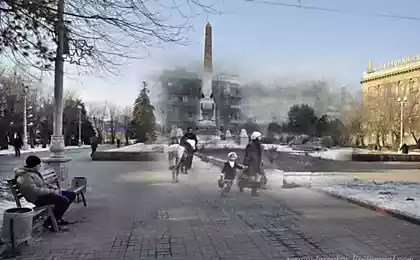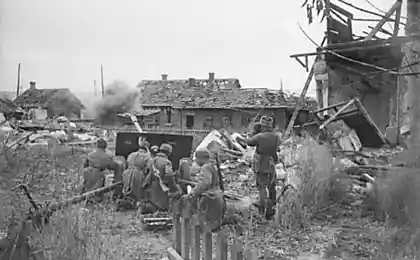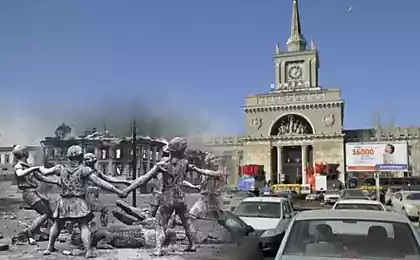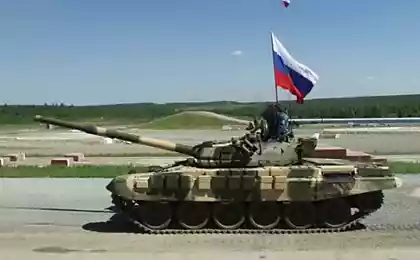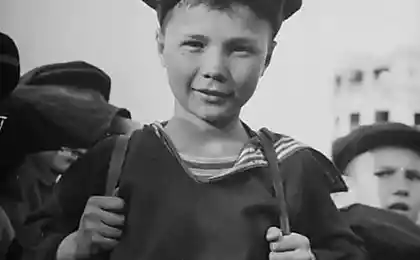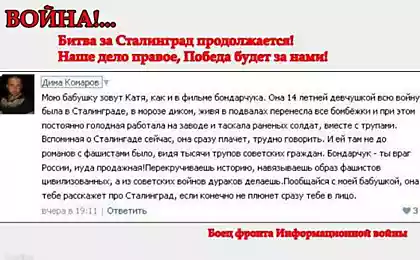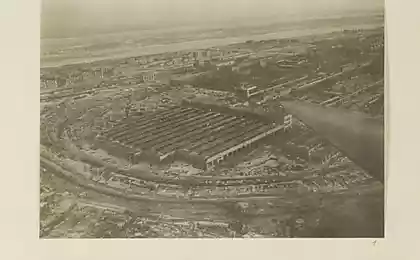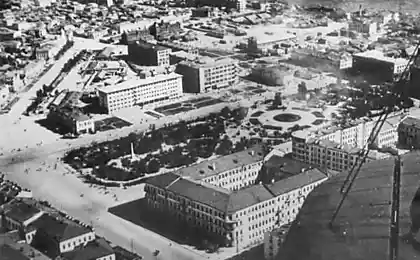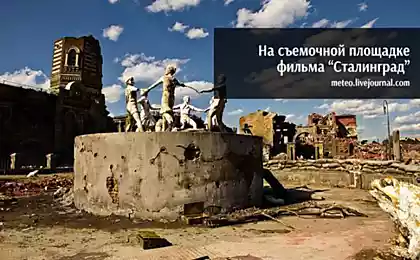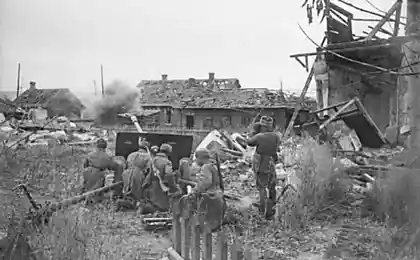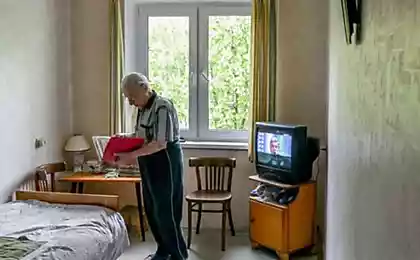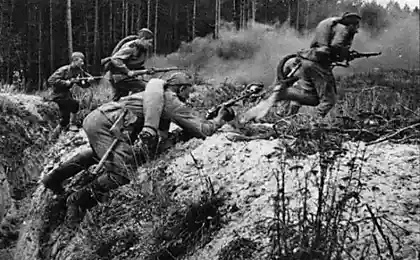1186
Ukrainian Stalingrad
End of January 1944
Aspect
On the part of the USSR:
27 infantry divisions, one mechanized and tank corps 4, only 255,000 people, 5,300 guns and mortars, 513tankov and self-propelled artillery, aircraft 772boevyh.
From Germany:
14 divisions, including 3 armored, motorized brigade 1 170 000 people, 2,600 guns and mortars, 310 tanks and assault guns, 1,053 combat aircraft.
Will be 21 photos.

As a result, Zhitomir -Berdichevskoy operation of the 1st Ukrainian Front
and Kirovograd operations of the 2nd Ukrainian Front, formed a deep ledge, which was defended by a large enemy force, which included nine infantry, one armored division and the motorized brigade with numerous reinforcements from the 1st Panzer and 8th Armies Army Group "South»
Front commander, Army General Vatutin Nikolai Fedorovich (1901-1944)

The commander of the 2nd Ukrainian Front, Army General Ivan Stepanovich Konev (1997-1973)
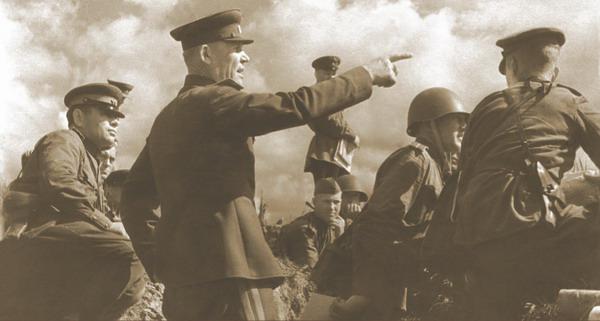
Commander of the Army Group "South" Field Marshal Erich von Manstein. (1887-1973)

Map offensive
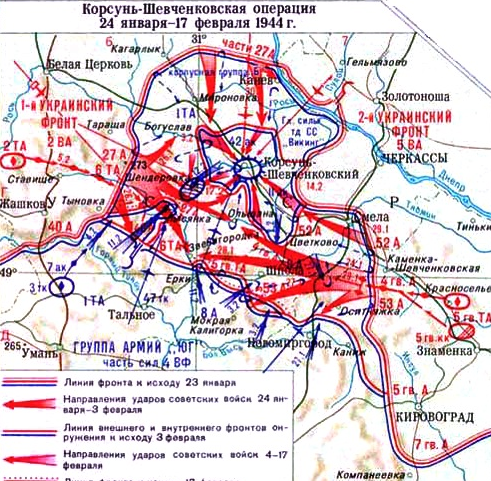
Hold the ledge, the enemy made it impossible to close fronts adjacent flanks, hindered their promotion to the Southern Bugu.Protivnik took vigorous measures to create near Korsun-projection stable defense that would ensure retention of the area and serves as an initial area of deployment of offensive action. It should be emphasized that the terrain in the area is very conducive to the creation of the projection defense. Numerous rivers, streams, ravines with steep banks, a large number of settlements helped create defensive lines to a greater depth, as well as a number of switch positions. Heights, especially in the area of Caneva, provided good conditions for observing the enemy.
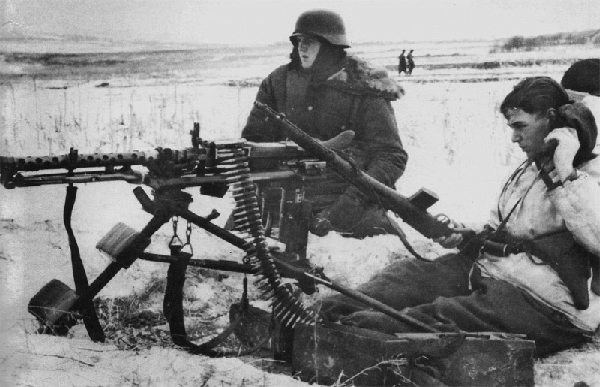
Stavka put the 1st and 2nd Ukrainian fronts task to encircle and destroy the enemy's forces in Korsun-ledge.
Thought Command troops supposed to put two fronts countered at the base of the projection and join in Shpola district, Zvenyhorodka.
"East Wall" (German. «Ostwall») - a strategic defensive line of German troops on the Soviet-German front, built by the fall of 1943. He passed through p. Narva, Pskov, Vitebsk, Orsha, p. SOG, middle reaches of. Dnipro (base "Eastern Wall"), p. Dairy. By the end of September 1943, Soviet troops broke through the "East Wall» ...

The offensive has been identified: the 1st Ukrainian Front - January 26, 2nd Ukrainian - January 25. The difference is caused by the difference in terms of distance, which must overcome the shock troops of fronts to Zvenigorodka, t. E. To the point where they had to connect.
The troops of the 2nd Ukrainian Front launched an offensive on January 24, the 1st Ukrainian Front - January 26. After breaking through the enemy's defenses, strike groups fronts rushed towards each other. At the 2nd Ukrainian Front on January 25 in a breakthrough it was introduced 5th Guards Tank Army, rapidly advances to Zvenigorodka. At the 1st Ukrainian Front 6th Panzer Army also pulled ahead by developing success Zvenigorodka.
The commander of the 5th General TA Ts Rotmistrov Pavel (1901-1982)
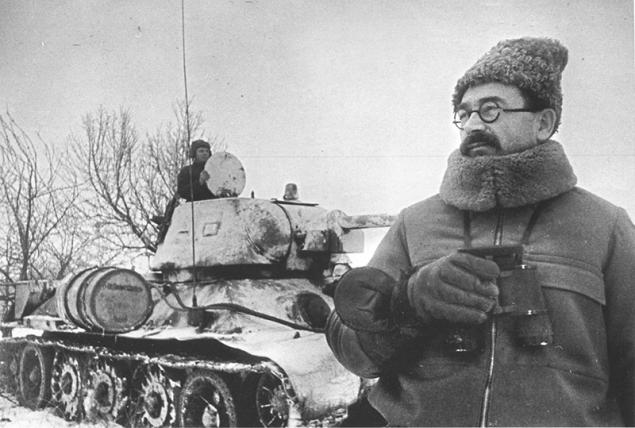
The commander of the 6th TA Kravchenko Andrew G. (1899-1963)
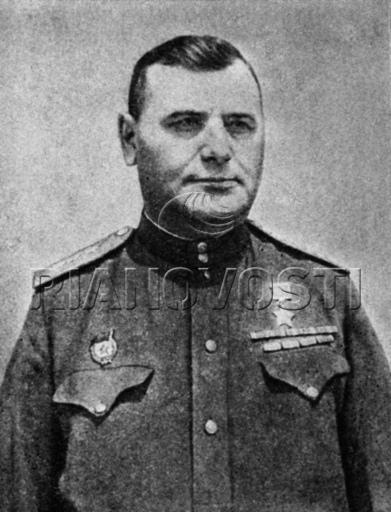
January 27 the German command took a counterattack against the troops of the 2nd Ukrainian Front, with a view to close the resulting as a result of a breakthrough in breach of its defense. Since the advancing Soviet troops stretched significantly, the Germans managed to achieve tactical success. Leading 20th and 29th Tank Corps of 5th Guards Tank Army were cut off from the main forces of blows V SS-Panzer-Division "Wiking"
V SS-Panzer-Division "Wiking" on the march under Olshanoy.
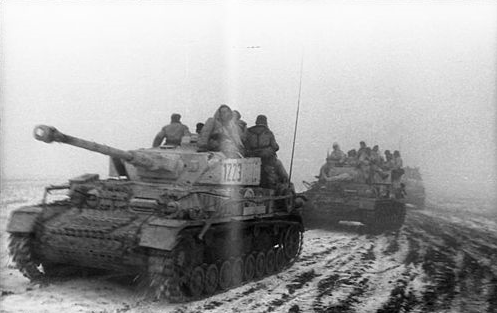
Nevertheless, the commander of the 20th Panzer Corps, Lieutenant-General IG Lazarev decided to continue the attack, despite the threat of encirclement. By the end of the day of its tankers knocked the Germans out of the village Shpola, which is 35 kilometers from Zvenigorodka.
Tank landing
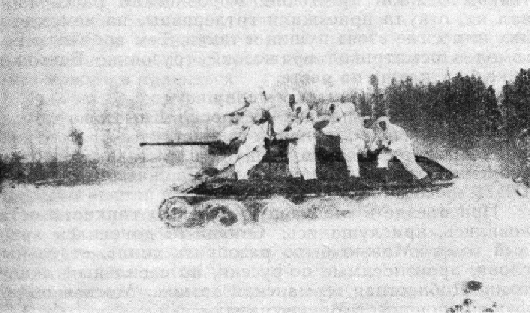
Well aware of the extreme danger of the current situation for the two buildings Rotmistrov Panzer Army, commander of the 1st Ukrainian Front, decided to provide immediate assistance to their neighbors. Towards the tanks Lazarev it sent shock mobile group under the command of Major-General MI Savelyev as part of the 233rd Tank Brigade, in 1228 the first self-propelled artillery regiment, a motorized infantry battalion and battery anti-tank artillery.
76-year-mm self-propelled artillery systems
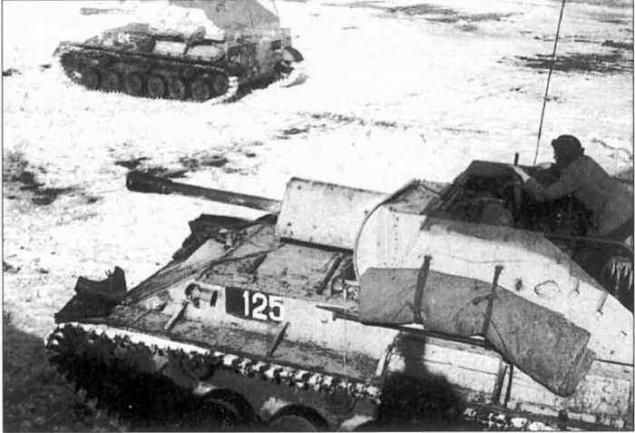
Group Saveliev successfully broke through the German defense orders in the area Lisyanka and rapidly began to move to the rear of the enemy. January 28 tankers Lazarev and Savelyev joined in Zvenigorodka, completing the encirclement of Cherkassy German group.
Tanks 20 Tank Corps under Olshanami
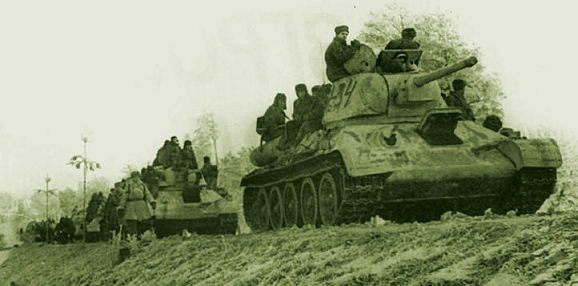
Simultaneously, the troops of both fronts to create a foreign encirclement in order to prevent the Germans to carry out the operation on its deprotected surrounded parts. The German command was forced to stop the counter-attacks against the troops of the 1st Ukrainian Front to the east and north of Uman, Vinnytsia, and all armored divisions to transfer to rescue troops surrounded.
SS-Panzer-Division Leibstandarte-SS Adolf Hitler goes to Breakthrough "boiler»
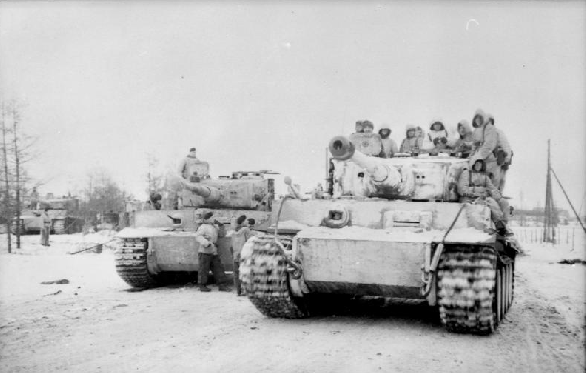
By the end of February 3, Soviet troops completed a full entourage entire Korsun-Shevchenko enemy group, setting a solid front line. February 4-5, Nazi troops unsuccessfully repeated attempts to break through the encirclement blows in the direction of Shpola. Also unsuccessful were attempts to break through the encirclement of the enemy in the area of the 1st Ukrainian Front from the area on Rizino Lysyanka.
The Soviet command in order to avoid unnecessary bloodshed proposed February 8 German troops to surrender. But deceived by promises of assistance from Hitler, they refused to surrender and continued resistance.
Soviet troops, clutching the encirclement continued elimination of enemy forces. Until February 12, the destruction was carried out by the two fronts, and then the troops of the 2nd Ukrainian Front. On February 11, the enemy counter-attack struck a large force five panzer divisions from the area north of Buka and Erki in the general direction Shanderovku.
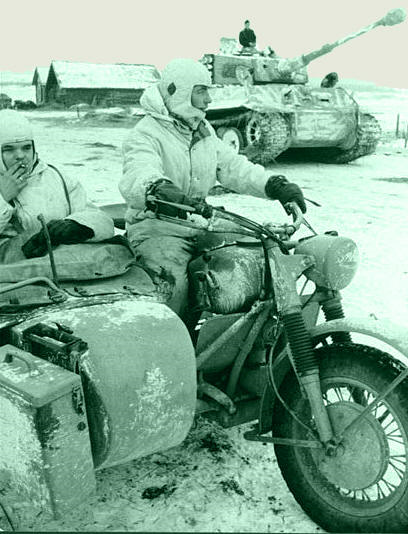
February 12 launched an offensive group and troops surrounded the turn-Steblev Tarascha toward the Lysyanka. Heavy losses advancing German divisions managed by 16 February to reach the line Chesnovka-Lysyanka. Rushes from the environment forces the Germans at the same time took possession of the area Hilke-Komarovka and Novo-Buda, but to connect with the divisions, advancing to meet them, they still do not udalos.K the same German technology was powerless to early to start and mudslides
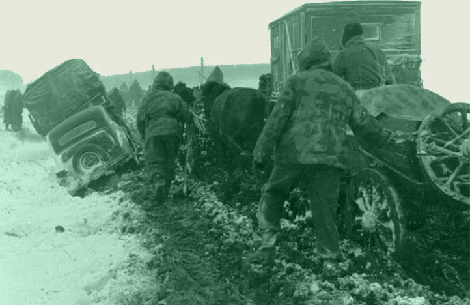
The enemy was first stopped and then crushed and destroyed. The troops of the 2nd Ukrainian Front swift blow on February 14, captured the Korsun-Shevchenko.
Broken German technology in Korsun-Shevchenko
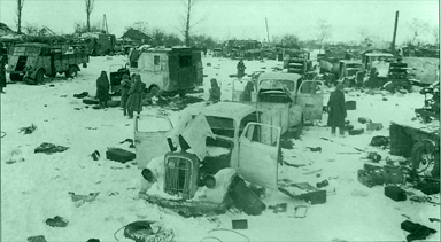
The last attempt of the Germans to withdraw from the environment took place on February 17th. In the first echelon were three columns: the 5th SS Panzer Division "Viking" to the left, 72 Infantry Division in the center and cabinet group "B" on the right wing. In aregarde were 57th and 88th Infantry Divisions.
"Viking" - the last hope surrounded ...

German troops broke through between the villages and Zhurzhintsy Pochapintsy directly to October, but many of the shelling from a height of 239 went to the south of it, and even further south and out Pochapintsev rot Tikachu where there were no crossings. This has led to major losses both from hypothermia while trying to cross to the improvised means, and from the attacks of the Soviet troops.
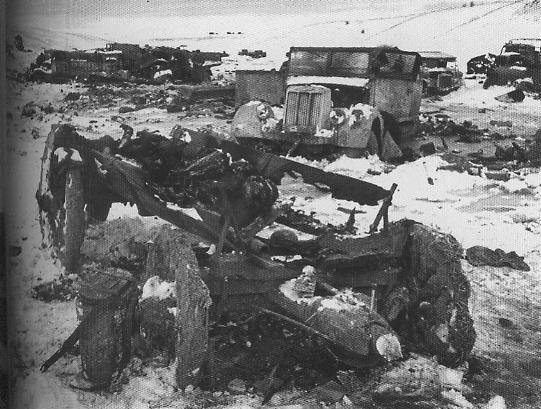
The main blow fell on the 5th Guards. Airborne, 180th and 202nd Infantry Divisions in the inner ring of the environment and the 41st Guards. Infantry Division on the outer. That was the last splash resistance. Marines honorably withstood the onslaught agonichny and destroy the enemy.
At the same time the 18th and 29th Panzer Corps moved towards each other, with orders to kill or capture the enemy. According to the memoirs Konev, "tanks operated with lighted lamps, fire and maneuver, they pressed the enemy without letting him out of the boiler & quot; ...
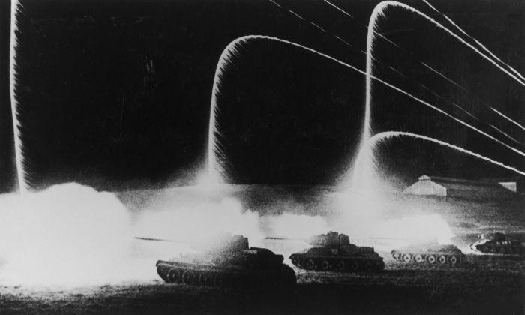
Feb 17. 1944, all surrounded by a group of Nazi troops ceased to exist. As a result of fierce fighting the Germans lost 55 thousand killed and more than 18 thousand prisoners. 40423 Germans managed to escape. Our irrecoverable losses amounted to 24,286 people. Only the forces of the 2nd Ukrainian Front were captured 41 aircraft, 167 tanks and self-propelled guns, 618 field guns of various calibers, 267 mortars, 789 machine guns, 10 000 vehicles, 7 locomotives and 415 cars and tanks, 127 trucks and other trophies.
Historians point to the German side of the Nazis deadweight loss in the region of 39,700 people. But this figure is impressive - more so that the enemy had superiority as a defender.

Cannes on the Dnieper Ukrainian Stalingrad, the Battle of the Korsun-Shevchenko - as soon not call at the time the victory of the Soviet troops at Korsun. A lot of time has passed with the cloudy and unstable winters with heavy snowfalls and thaws, when able to once and for all clear the Germans from the glorious history of the Ukrainian people places.
hence
www.opoccuu.com/170212.htm
www.cherrysoft.ru/interesting/9830-...1941-1945g.html
www.rusfact.ru/node/6036
Peter Krivonogov. Korsun-slaughter. Picture 1964
all.
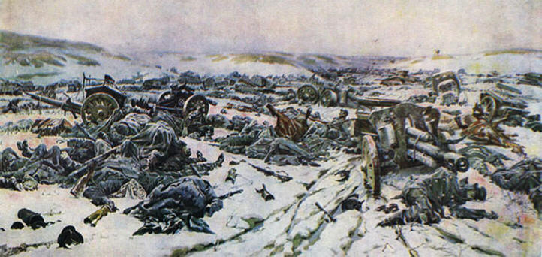
Source:
Aspect
On the part of the USSR:
27 infantry divisions, one mechanized and tank corps 4, only 255,000 people, 5,300 guns and mortars, 513tankov and self-propelled artillery, aircraft 772boevyh.
From Germany:
14 divisions, including 3 armored, motorized brigade 1 170 000 people, 2,600 guns and mortars, 310 tanks and assault guns, 1,053 combat aircraft.
Will be 21 photos.

As a result, Zhitomir -Berdichevskoy operation of the 1st Ukrainian Front
and Kirovograd operations of the 2nd Ukrainian Front, formed a deep ledge, which was defended by a large enemy force, which included nine infantry, one armored division and the motorized brigade with numerous reinforcements from the 1st Panzer and 8th Armies Army Group "South»
Front commander, Army General Vatutin Nikolai Fedorovich (1901-1944)

The commander of the 2nd Ukrainian Front, Army General Ivan Stepanovich Konev (1997-1973)

Commander of the Army Group "South" Field Marshal Erich von Manstein. (1887-1973)

Map offensive

Hold the ledge, the enemy made it impossible to close fronts adjacent flanks, hindered their promotion to the Southern Bugu.Protivnik took vigorous measures to create near Korsun-projection stable defense that would ensure retention of the area and serves as an initial area of deployment of offensive action. It should be emphasized that the terrain in the area is very conducive to the creation of the projection defense. Numerous rivers, streams, ravines with steep banks, a large number of settlements helped create defensive lines to a greater depth, as well as a number of switch positions. Heights, especially in the area of Caneva, provided good conditions for observing the enemy.

Stavka put the 1st and 2nd Ukrainian fronts task to encircle and destroy the enemy's forces in Korsun-ledge.
Thought Command troops supposed to put two fronts countered at the base of the projection and join in Shpola district, Zvenyhorodka.
"East Wall" (German. «Ostwall») - a strategic defensive line of German troops on the Soviet-German front, built by the fall of 1943. He passed through p. Narva, Pskov, Vitebsk, Orsha, p. SOG, middle reaches of. Dnipro (base "Eastern Wall"), p. Dairy. By the end of September 1943, Soviet troops broke through the "East Wall» ...

The offensive has been identified: the 1st Ukrainian Front - January 26, 2nd Ukrainian - January 25. The difference is caused by the difference in terms of distance, which must overcome the shock troops of fronts to Zvenigorodka, t. E. To the point where they had to connect.
The troops of the 2nd Ukrainian Front launched an offensive on January 24, the 1st Ukrainian Front - January 26. After breaking through the enemy's defenses, strike groups fronts rushed towards each other. At the 2nd Ukrainian Front on January 25 in a breakthrough it was introduced 5th Guards Tank Army, rapidly advances to Zvenigorodka. At the 1st Ukrainian Front 6th Panzer Army also pulled ahead by developing success Zvenigorodka.
The commander of the 5th General TA Ts Rotmistrov Pavel (1901-1982)

The commander of the 6th TA Kravchenko Andrew G. (1899-1963)

January 27 the German command took a counterattack against the troops of the 2nd Ukrainian Front, with a view to close the resulting as a result of a breakthrough in breach of its defense. Since the advancing Soviet troops stretched significantly, the Germans managed to achieve tactical success. Leading 20th and 29th Tank Corps of 5th Guards Tank Army were cut off from the main forces of blows V SS-Panzer-Division "Wiking"
V SS-Panzer-Division "Wiking" on the march under Olshanoy.

Nevertheless, the commander of the 20th Panzer Corps, Lieutenant-General IG Lazarev decided to continue the attack, despite the threat of encirclement. By the end of the day of its tankers knocked the Germans out of the village Shpola, which is 35 kilometers from Zvenigorodka.
Tank landing

Well aware of the extreme danger of the current situation for the two buildings Rotmistrov Panzer Army, commander of the 1st Ukrainian Front, decided to provide immediate assistance to their neighbors. Towards the tanks Lazarev it sent shock mobile group under the command of Major-General MI Savelyev as part of the 233rd Tank Brigade, in 1228 the first self-propelled artillery regiment, a motorized infantry battalion and battery anti-tank artillery.
76-year-mm self-propelled artillery systems

Group Saveliev successfully broke through the German defense orders in the area Lisyanka and rapidly began to move to the rear of the enemy. January 28 tankers Lazarev and Savelyev joined in Zvenigorodka, completing the encirclement of Cherkassy German group.
Tanks 20 Tank Corps under Olshanami

Simultaneously, the troops of both fronts to create a foreign encirclement in order to prevent the Germans to carry out the operation on its deprotected surrounded parts. The German command was forced to stop the counter-attacks against the troops of the 1st Ukrainian Front to the east and north of Uman, Vinnytsia, and all armored divisions to transfer to rescue troops surrounded.
SS-Panzer-Division Leibstandarte-SS Adolf Hitler goes to Breakthrough "boiler»

By the end of February 3, Soviet troops completed a full entourage entire Korsun-Shevchenko enemy group, setting a solid front line. February 4-5, Nazi troops unsuccessfully repeated attempts to break through the encirclement blows in the direction of Shpola. Also unsuccessful were attempts to break through the encirclement of the enemy in the area of the 1st Ukrainian Front from the area on Rizino Lysyanka.
The Soviet command in order to avoid unnecessary bloodshed proposed February 8 German troops to surrender. But deceived by promises of assistance from Hitler, they refused to surrender and continued resistance.
Soviet troops, clutching the encirclement continued elimination of enemy forces. Until February 12, the destruction was carried out by the two fronts, and then the troops of the 2nd Ukrainian Front. On February 11, the enemy counter-attack struck a large force five panzer divisions from the area north of Buka and Erki in the general direction Shanderovku.

February 12 launched an offensive group and troops surrounded the turn-Steblev Tarascha toward the Lysyanka. Heavy losses advancing German divisions managed by 16 February to reach the line Chesnovka-Lysyanka. Rushes from the environment forces the Germans at the same time took possession of the area Hilke-Komarovka and Novo-Buda, but to connect with the divisions, advancing to meet them, they still do not udalos.K the same German technology was powerless to early to start and mudslides

The enemy was first stopped and then crushed and destroyed. The troops of the 2nd Ukrainian Front swift blow on February 14, captured the Korsun-Shevchenko.
Broken German technology in Korsun-Shevchenko

The last attempt of the Germans to withdraw from the environment took place on February 17th. In the first echelon were three columns: the 5th SS Panzer Division "Viking" to the left, 72 Infantry Division in the center and cabinet group "B" on the right wing. In aregarde were 57th and 88th Infantry Divisions.
"Viking" - the last hope surrounded ...

German troops broke through between the villages and Zhurzhintsy Pochapintsy directly to October, but many of the shelling from a height of 239 went to the south of it, and even further south and out Pochapintsev rot Tikachu where there were no crossings. This has led to major losses both from hypothermia while trying to cross to the improvised means, and from the attacks of the Soviet troops.

The main blow fell on the 5th Guards. Airborne, 180th and 202nd Infantry Divisions in the inner ring of the environment and the 41st Guards. Infantry Division on the outer. That was the last splash resistance. Marines honorably withstood the onslaught agonichny and destroy the enemy.
At the same time the 18th and 29th Panzer Corps moved towards each other, with orders to kill or capture the enemy. According to the memoirs Konev, "tanks operated with lighted lamps, fire and maneuver, they pressed the enemy without letting him out of the boiler & quot; ...

Feb 17. 1944, all surrounded by a group of Nazi troops ceased to exist. As a result of fierce fighting the Germans lost 55 thousand killed and more than 18 thousand prisoners. 40423 Germans managed to escape. Our irrecoverable losses amounted to 24,286 people. Only the forces of the 2nd Ukrainian Front were captured 41 aircraft, 167 tanks and self-propelled guns, 618 field guns of various calibers, 267 mortars, 789 machine guns, 10 000 vehicles, 7 locomotives and 415 cars and tanks, 127 trucks and other trophies.
Historians point to the German side of the Nazis deadweight loss in the region of 39,700 people. But this figure is impressive - more so that the enemy had superiority as a defender.

Cannes on the Dnieper Ukrainian Stalingrad, the Battle of the Korsun-Shevchenko - as soon not call at the time the victory of the Soviet troops at Korsun. A lot of time has passed with the cloudy and unstable winters with heavy snowfalls and thaws, when able to once and for all clear the Germans from the glorious history of the Ukrainian people places.
hence
www.opoccuu.com/170212.htm
www.cherrysoft.ru/interesting/9830-...1941-1945g.html
www.rusfact.ru/node/6036
Peter Krivonogov. Korsun-slaughter. Picture 1964
all.

Source:
